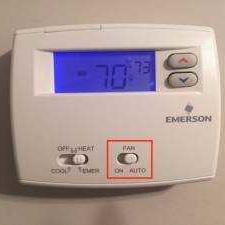Cleaning Hack: How to Remove Dust from Your Home Using Your Air Conditioner
Does it seem like no matter how much you dust, sweep and vacuum the dust is all back in no time?
The possible cause: You’re moving around the same dust. You see, when you dust and vacuum your home, dirt and dust are released into your home’s air where it can take awhile (a few hours to a day) to settle down.
And as the dust settles, it lands on your furniture and makes your home dusty again. So you clean again. And the cycle repeats.
So how do you end this crazy cycle? Try this:
Switch your thermostat to ON when dusting and vacuuming

What this does: Turning your thermostat to ON turns the air conditioner’s fan on, even if the air conditioner isn’t cooling your home.
Why this helps dust your home: Some of the dirt and dust that gets into your air when you vacuum and dust is sucked up by your AC system, captured by the AC filter.
Of course, this works best when you have a high-quality filter in your air conditioning and heating system. So that’s why you might want to...
Upgrade your dust-capture system with a better filter
Most air conditioning and heating systems come with a very basic fiberglass filter, which only catches about 10% of the dust that your fan sucks up.
So for a better best dust-capture system, you want to upgrade to a more effective air filter.
How to find a high-quality air filter
An air filter’s effectiveness at removing airborne particles is measured in MERV (Minimum Efficiency Reporting Value). The higher the number, the better it can remove particles from the air. You can choose from 4 basic categories of AC/furnace filters:
- MERV 1-4: Basic throw-away filters—Remove as little as 10% of airborne contaminants. These are usually fiberglass or another cheap material and are $1 or so each.
- MERV 10-13: Pleated air filters—Can be used as replacements to the fiberglass filters. They remove up to 45% of the pollutants from the air, and they’re slightly more expensive, starting around $10 each.
- MERV 14-16: Large pleated air filters—Require some modification to your duct system as they’re several inches thick. They remove up to 85% of the airborne contaminants that passes through them and can be $100+.
- MERV 17-20: Whole-home air cleaners—Comes in the form of a whole-home air cleaner. And they can capture up to 98% of all airborne contaminants.
Caution: Don’t do this if your air ducts are leaky
Don’t use our hack If your air ducts are leaky. Leaky ducts can actually make your home even more dusty.
Here’s how: As your air conditioning and heating system circulates air throughout your home, leaky ductwork can suck in dirt and debris from your attic.

Diagram showing a duct leak on the return side.
“But how do I know if my air ducts are leaky?”
Energy Star says you might have leaky air ducts if you have:
- Extremely high summer and winter utility bills
- Rooms that are difficult to heat and cool
- Stuffy rooms that never seem to feel comfortable
- Tangled or kinked flexible ducts in your attic or basement
But the best way to know if your ducts are leaking is to have an air conditioning company inspect your ductwork.
Get help from the Twin Cities’ AC pros
Contact MSP Plumbing, Heating and Air Conditioning today. We can help you find and install a better air filter. Also, we can check your ductwork for leaks and then seal them if needed.

